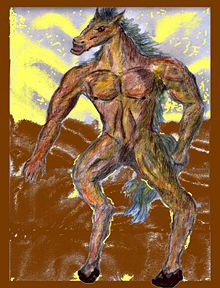| Revision as of 18:57, 11 September 2022 editSpinningspark (talk | contribs)89,216 edits →References: Already included in daughter cat← Previous edit | Revision as of 07:57, 16 November 2022 edit undoThe night king kills Arya in the winds of winter (talk | contribs)31 edits Better imageTags: Reverted Mobile edit Mobile web editNext edit → | ||
| Line 1: | Line 1: | ||
| ] | ] | ||
| '''Ipotanes''' or '''hippotaynes''' are mythical creatures; a race of half-], half-humans. They are usually depicted as the reverse of ]s, having human bodies with the heads of horses. Although sometimes attributed to ], the term appears to have originated at a much later date, and without a definite description; they are first mentioned in ]'s fourteenth-century ''Travels''. Ipotanes appear in modern works of the ]. | '''Ipotanes''' or '''hippotaynes''' are mythical creatures; a race of half-], half-humans. They are usually depicted as the reverse of ]s, having human bodies with the heads of horses. Although sometimes attributed to ], the term appears to have originated at a much later date, and without a definite description; they are first mentioned in ]'s fourteenth-century ''Travels''. Ipotanes appear in modern works of the ]. | ||
Revision as of 07:57, 16 November 2022

Ipotanes or hippotaynes are mythical creatures; a race of half-horse, half-humans. They are usually depicted as the reverse of centaurs, having human bodies with the heads of horses. Although sometimes attributed to Greek mythology, the term appears to have originated at a much later date, and without a definite description; they are first mentioned in John de Mandeville's fourteenth-century Travels. Ipotanes appear in modern works of the fantasy genre.
John de Mandeville
In his 1356 travelogue, The Travels of Sir John Mandeville, the author reports the existence of a violent race of ipotanes, found in Bacharie (Bactria).
...ben many Ipotanes that dwellen sometime in the water and sometime on the land; and thei ben half men and half hors and thei eten men when thei may take him
— Wyken and Worde, 1499.
More recent editions of Mandeville's work use various spellings; hippotaynes (Macmillan, 1900), hippopotami (Penguin, 1983).
Description
The word "ipotane" appears to be derived from the Greek ιππότης (hippotes), "a knight". Mandeville's description is not clearly distinguishable from that of a centaur, and some depictions use the term synonymously. Other depictions show ipotanes with a human body and a horse's head, sometimes with the legs or tail of a horse.
Modern literature
Despite their similarity to centaurs, ipotanes are not mentioned in the corpus of Greek and Roman literature. However, they appear in works of fantasy literature, in which they are depicted with various combinations of horselike and human features.
See also
References
- Charles Knight, Charles Knight's Popular History of England, vol. 2, p. 13, London: Bradbury, Evans, & Company, 1862–67 OCLC 942643783.
- ^ John Vinycomb, Fictitious & Symbolic Creatures in Art, p. 144, Gale Research Company, 1906 ISBN 0810331470.
- Sir John Mandeville, A.W. Pollard (ed), The Travels Of Sir John Mandeville, p. 177, London: Macmillan & Co., 1900 OCLC 1268064505
- Sir John Mandeville, C.W.R.D. Pollard (trans), The Travels Of Sir John Mandeville, p. 167, Penguin, 1983 OCLC 1261243004.
- Henry George Liddell, Robert Scott, A Greek-English Lexicon, p. 708, Oxford: Clarendon Press, 1890 OCLC 493157397.
-
- For example,
- Nancy A. Collins, Right Hand Magic: A Novel of Golgotham, Penguin, 2010 ISBN 1101445777
- Amanda Bouchet, A Promise of Fire, Hachette UK, 2016 ISBN 0349412537.